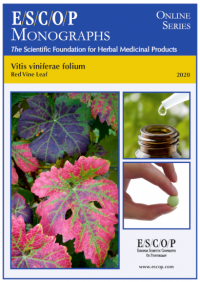
ESCOP monographs The Scientific Foundation for Herbal Medicinal Products. Online series. Vitis viniferae folium (Red vine leaf). Exeter: ESCOP; 2020.
Vitis viniferae folium
Red vine leaf
Vitis vinifera L.
Published: 2020
Format: PDF, 17 pages
>> Online viewing (for only ¤30 per year, you can view online all the monographs; free for members of SEFIT)
>> Download monograph (Euros 15,- for general public, Euros 12,- for members of SEFIT)
SUMMARY
The herbal monograph selects and summarises scientific studies and textbooks regarding efficacy, dosage, and safety to support the therapeutic uses of red vine leaf.
This herbal drug by definition consists of the dried leaves from cultivars of Vitis vinifera L., characterized by black grapes and red pulp.
Its main characteristic constituents are flavonoids (up to 3.5%), such as quercetin glycosides, kaempferol 3-glucoside, as well as anthocyanins and proanthocyanidins.
The therapeutic indications are symptoms of chronic venous insufficiency (CVI) and chronic venous disorders (CVD), varicosis, and couperosis, as well as hemorrhoids. Administration of red vine leaf addresses posology; its duration of use; contra-indications; special warnings; special precautions for use; interactions with other medicinal products; other forms of interaction; in pregnancy and lactation; its effects on the ability to drive; undesirable effects; overdose.
In vitro experiments with red vine leaf demonstrated protection of venous endothelium, antiherpetic, antispasmodic, antiparasitic, antimicrobial, anti-inflammatory, antioxidant and cytotoxic effects. In vivo experiments with red vine leaf or its extracts demonstrated anti-hyaluronidase activity, increased capillary resistance, hepatoprotective, nephroprotective, anti-inflammatory, antinociceptive, antipyretic, swimming endurance, and antidiabetic properties.
Controlled clinical studies with red vine leaf aqueous dry extracts demonstrated its use in patients with CVI.
No data are available on the pharmacokinetic properties of red vine leaf extracts.
Preclinical safety data were assessed in toxicity studies.
Safety data were assessed in human studies using mainly aqueous extracts. These were generally well tolerated. Reported adverse events were usually mild in nature.
The selection of literature cited in the monograph is aimed at bringing together relevant information about the possible physiological roles of red vine leaf and its aqueous extracts.
KEYWORDS
- Vitis viniferae folium
- Red vine leaf
- Vitis vinifera L.
- Circulatory disorders
- Chronic venous disorders
- Chronic venous insufficiency
- Varicosis
- Couperosis
- Haemorrhoids
